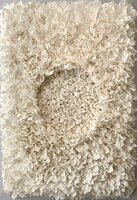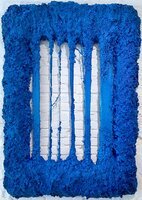Christian De WULF
© Christian De WULF
Christian De Wulf is a Belgian contemporary artist.
The visual impact is of a sense of psychological displacement, putting the emphasis on what is missing rather than on what is depicted
Human beings try to realize personal wishes and longings in a constant fight with the conventions and the expectations of the outside world.
This inner struggle, which is altogether personal and universal, is what fascinates the artist. It's his ambition to speak the unspoken, to show the invisible, to open up the hidden, to unlock the enclosed.
To turn emotions into visual structures. Therefore, he creates abstract landscapes on canvas. With different layers of acryl paint he transforms the canvas into a smooth looking, perfectly clean plane. From beneath this seemingly peaceful surface, an inner layer of paint breaks through, becomes thicker, invades, and finally conquers the canvas until it even crosses its borders in chaotic eruptions of massive granular paint. The balance has gone, the painting explodes into three dimensions. On recent works one canvas hides another. Depths and heights are covered up but seem to be bubbling under and to mold the upper surface. These paintings should be read as mind maps loaded with meaning and emotion and in a certain way, they are the sum of the artist's emotions. They lead the beholder through valleys of calm and peace to mountains of rage. They show unruffled rivers of equanimity that end in cascades of tears, resting volcanos of contentment that suddenly bursts out with uncontrollable magma of passion. From the moment hidden emotions are let loose they surpass the unspoken rules of conformity. Emotion wins over ratio. What at first seems to be geometrical dissolves into an abstract lyricism. The painting becomes a sculpture. The artist’s communication with his beholder goes further than that. He orders his works in themes like reverie in black and white, or who’s afraid of. They are vague, refer to an emotion, a certain atmosphere. Each painting is a link in a chain, is a different point of view to look at the theme, is a different way to work out a common structure. They all get their own name in the form of a sentence that reminds the painter of the state of mind he was in when he was painting. Most of these sentences suggest a longing for communication, for understanding. They become a gate through which, a key with which the beholder can enter this abstract world. So, the work of art not only becomes a metaphor for the meeting between surface and structure, between light and shadow, tranquility and unrest. The confrontation between the artist and the outside world, which is reflected in his work of art, finds its ultimate mirror in the intimate communication between artist and beholder.






